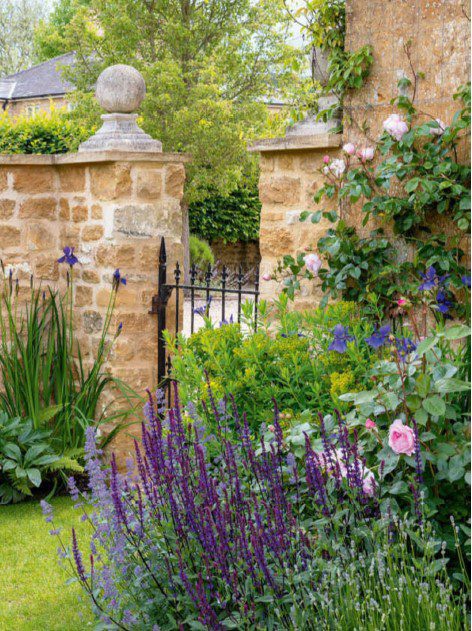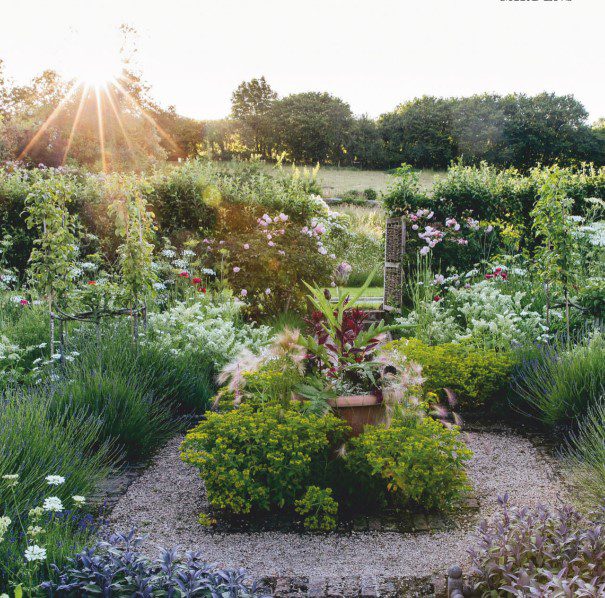HOW TO CREATE A COTTAGE GARDEN
Classic English country-style spaces are back on the design agenda as we continue to find beauty in simple things.
The ‘Cottagecore’ movement embracing the outdoors and slow living greatly influence our aesthetic and lifestyle choices.
We are yearning for simplicity in a world fraught with complications, so it is no surprise that a traditional approach is now popular for both country and urban gardens.
According to garden designer Tracy Foster MSGD, plants in a cottage garden earned their place by being easy to grow, useful, edible, or a mix of all three.
All qualities are high on our agenda in 2021. Tracy also claims that ‘the resulting symphony of shape, texture, color, and scent can bring a bucolic charm to any plot, even one
in the heart of a city.’
THE RIGHT FLOWERS
For a truly authentic cottage look, there will be a variety of different shapes and forms. Landscape and garden designer Ana Mari Bull MSGD recommends using the past as a guide.
‘Where possible, look at modern cultivar equivalents of the plants that would have grown in a Victorian cottage garden; she says.
‘Roses are the obvious choice, but they must be scented.’ Tracy Foster adds height with hollyhocks, foxgloves, and delphiniums.
For other flower shapes, try the flat panicles of achillea, ball-shaped inflorescences of
globe thistle or cheerful daisy flowers of Leucanthemum or rudbeckia.
WHEN TO GET PLANTING
Garden landscape designer Fi Boyle MSGD explains that there are two key times of year to plant. The first is the early autumn, when the soil is still warm and not waterlogged.
For Fi, the advantage of planting in the autumn is that the plants settle into warm earth and start to establish their roots before the winter months.
This means that when spring comes, they are ready to get going. However, if you have missed the autumn window, you can also plant in spring.
Bear in mind that you may need to keep a bit more of an eye on your plants at this time of year, as in In recent years, we have had some very dry springs.
CARING FOR YOUR BORDER
‘Always think right plant, right place; says garden designer Rosemary Coldstream. Your plants have the best start possible when in their ideal soil and sun conditions, so bear this in mind when selecting plants.
From there, Rosemary recommends deadheading regularly to prolong flowering. If your
the border is either heavy or very dry; mulch it with good quality compost.
When perennials get too big, lift and divide them to grow your plant collection and prevent overcrowding.
BRING IN THE BEES
There are plenty of nectar-rich plants but not all will be attractive to bees. Ana Mari Bull avoids plants that are wind-pollinated as they don’t need the help of insects.
She advises that double flowers, though attractive in a cottage border, should be avoided as bees can’t get into the plants and many are sterile.
For summer, Ana likes Geranium ‘Rozanne’ for small gardens and lavender for low hedging to edge a path.

Late winter and early spring supplies of pollen are important. She suggests hellebores, cyclamen, primroses, crocus, Lamium, Galanthus, Eranthis, and winter flowering
clematis as good options.
IDEAL PLANTING
The traditional cottage garden encapsulates a handmade, do-it-yourself style of gardening so when it comes to planting go for a mix of pretty flowers and edible plants – scented, herbal and healing varieties will by definition be beneficial to butterflies and bees.
FUNCTION AND FORM
A cottage-style garden still needs to pe1form in terms of successful design, so pathways and destinations need to be considered:
somewhere to sit in sun or shade, good views to exploit, and eyesores to screen, perhaps with a carefully located blossom tree for bees that, will also provide berries for birds later in the season.
MATERIAL CHOICES
Locally sourced, natural materials and building techniques set a garden in its place and echo what would have been used in the past.
Nearby salvage yards and local stone suppliers are a good starting point for paving
materials and consider searching out your local craftspeople for furniture and ornamental additions.
For terraces and pathways, the reclaimed stone is ideal, along with brick, if this chimes in with the locality, and gravel (cinder would have been used in the past).



























